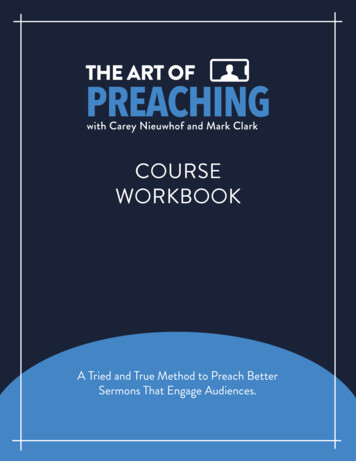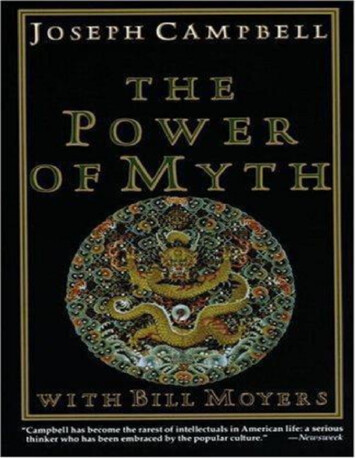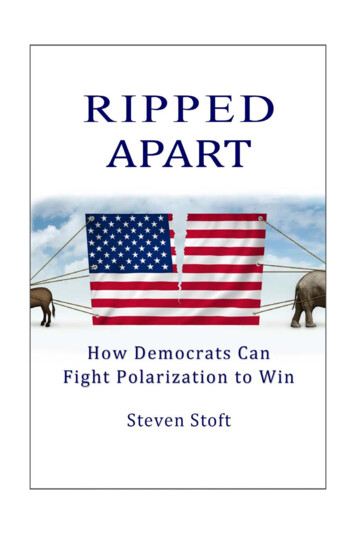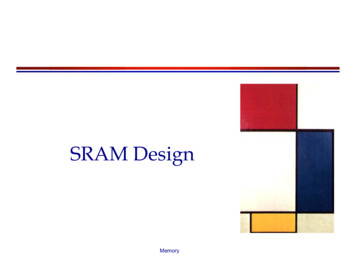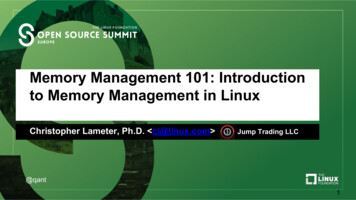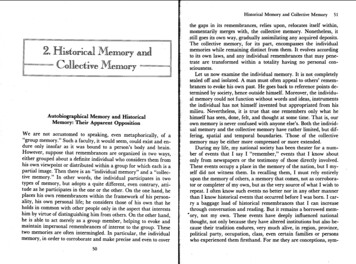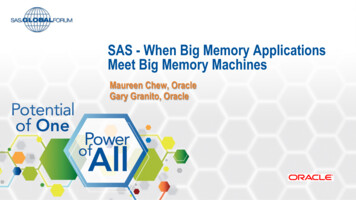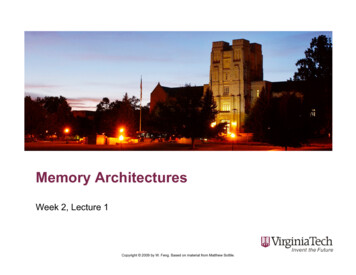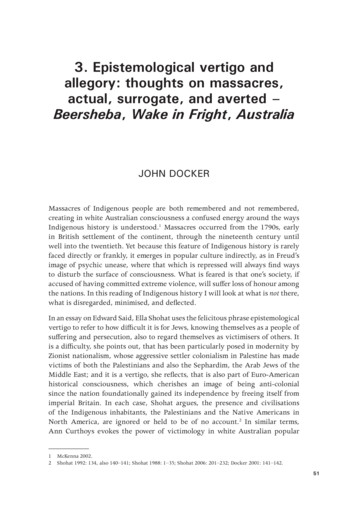
Transcription
3. Epistemological vertigo andallegory: thoughts on massacres,actual, surrogate, and averted –Beersheba, Wake in Fright, AustraliaJOHN DOCKERMassacres of Indigenous people are both remembered and not remembered,creating in white Australian consciousness a confused energy around the waysIndigenous history is understood.1 Massacres occurred from the 1790s, earlyin British settlement of the continent, through the nineteenth century untilwell into the twentieth. Yet because this feature of Indigenous history is rarelyfaced directly or frankly, it emerges in popular culture indirectly, as in Freud’simage of psychic unease, where that which is repressed will always find waysto disturb the surface of consciousness. What is feared is that one’s society, ifaccused of having committed extreme violence, will suffer loss of honour amongthe nations. In this reading of Indigenous history I will look at what is not there,what is disregarded, minimised, and deflected.In an essay on Edward Said, Ella Shohat uses the felicitous phrase epistemologicalvertigo to refer to how difficult it is for Jews, knowing themselves as a people ofsuffering and persecution, also to regard themselves as victimisers of others. Itis a difficulty, she points out, that has been particularly posed in modernity byZionist nationalism, whose aggressive settler colonialism in Palestine has madevictims of both the Palestinians and also the Sephardim, the Arab Jews of theMiddle East; and it is a vertigo, she reflects, that is also part of Euro-Americanhistorical consciousness, which cherishes an image of being anti-colonialsince the nation foundationally gained its independence by freeing itself fromimperial Britain. In each case, Shohat argues, the presence and civilisationsof the Indigenous inhabitants, the Palestinians and the Native Americans inNorth America, are ignored or held to be of no account.2 In similar terms,Ann Curthoys evokes the power of victimology in white Australian popular12McKenna 2002.Shohat 1992: 134, also 140–141; Shohat 1988: 1–35; Shohat 2006: 201–232; Docker 2001: 141–142.51
Passionate Historieshistorical consciousness and mythology, subtended by an uneasiness andanxiety that one’s society not be perceived as a perpetrator nation in relation toits Indigenous peoples.3Epistemological vertigo and allegory are drawn to each other, allegorysuggesting phenomena that cannot be faced directly, that are displaced intoother representations. Here I will explore how such allegorical displacementworks in Australian historical consciousness in relation to Indigenous massacres.The texts I will focus on are Paul Daley’s book Beersheba: A Journey ThroughAustralia’s Forgotten War, published in 2009, concerning events in Palestine in1917–1918; Baz Luhrmann’s wonderfully provocative film Australia, referringto history in Central and Northern Australia between 1939 and 1941, whichwas released in late 2008; and another remarkable film, Wake in Fright, made in1971 by the Canadian director Ted Kotcheff, beautifully restored and re-releasedin 2009. I want to think about three scenes of massacres actual, surrogate, andaverted. The actual scene is the Arab massacre by Anzac forces, Australians andNew Zealanders, in late 1918 in the Bedouin village of Surafend in Palestine.The other scenes are fictional and involve the massacre of kangaroos in Wakein Fright, and, averted at the last moment, of cattle in Australia, remindingus that, in terms of environmental history, massacre can involve slaughter ofanimals. Massacre indeed is etymologically associated with animals; the wordtraditionally used in France for the butcher’s chopping block, in the sixteenthcentury it gained its modern meaning, which then spread from France toEngland.4I will regard the three scenes of massacre in my chosen texts as allegorical. Interms of method, what interests me in exploring these texts, whether they areworks of history like Beersheba or films like Wake in Fright and Australia, isthe play of genre, textual tensions and stresses, ambivalences, narratives andcounter narratives, stray details, obfuscations, and oddities.5I suggest that a haunting dyad, legible in all three texts in different ways,of heroic values and dishonourable massacre, helps to shape, destabilise andbring incoherence to, white Australian historical memory and consciousness.The haunting can never be resolved and will always require new, impossible,attempts to create an unambiguous narrative. The textual result is confusion,even discursive and aesthetic chaos.34552Curthoys 1999: 1–18; also Docker 2008a: 113–144.Levene 1999: 7–9; also Greengrass 1999: 69.Docker 2008a: 92.
Epistemological vertigo and allegoryMassacre studies and world historyIn the last several years I have been involved in genocide and massacre studies,‘world history’ fields that are quite closely related, for both question and explorehumanity at its limits; but they are also to some degree distinct.6 Genocide as amode of inter-group violence frequently involves massacre, yet massacres can bea more diffuse phenomenon, involving, for example, as Mark Levene suggests inthe introduction to The Massacre in History, the actions of a single individual.7A feature of the field is what Jacques Semelin emphasises, the difficulty ofexplanation.8 We need to know more why in massacres groups suddenly turn ontheir neighbours with whom there may have been friendly relations for manyyears; we ask why massacres occur at certain times and not others; we wonderhow massacres can be both carefully thought out and yet exhibit emotion andfrenzy of an almost erotic kind; why they frequently involve the most appallingatrocities, as in mutilation, dismemberment, disembowelling, cannibalism, thedrowning of or setting fire to victims; we observe that massacres often involvemolestation of women including kidnapping, disfigurement, and rape.9There is also the ‘world history’ question of the relationship between Europeancolonisation and massacre. Massacres, as Lyndall Ryan and Ray Evans discuss sowell in their essays in this book, were an integral part of the colonising of Australia,a primary and characteristic mode of what late twentieth century internationallaw would identify as ethnic cleansing. Lyndall Ryan challenges historiographyto recognise how frequently massacres were deployed as a means of destroyingand clearing from desired land the continent’s Indigenous societies and peoples.Ray Evans points to the recurring methods of the coloniser perpetrators, thatthey simultaneously acted and concealed evidence as they acted, especially inthe burning of bodies. Colonial massacres, Evans reflects, were accompanied bycodes of secrecy and silence, or obfuscatory language and indirect references;key records were lost; perpetrators already were or might become importantmen of standing in colonial society, commercially and politically. We can alsonote that the colonising of the Australian continent from late in the eighteenthcentury was preceded by centuries of European colonisation elsewhere, creatinga repertoire of methods and techniques that included massacre, and manycolonisers, soldiers of empire, and imperial administrators moved betweenvarious colonies.10 In these trans-empire and transcolonial terms, we can say that6 Docker 2010.7 Levene 1999: 1, 5.8 Semelin 2003: 204, 208–209.9 Semelin 2003: 208. For the massacres that frequently occur during partitions, see also Khan 2007; Pandey2001.10 Cf Lambert and Lester 2006: 24, note 94.53
Passionate Historiesfrom 1492, taken as a collective, the European colonisers of other peoples’ lands,around the world, when they considered there was a need, proved themselvespractised massacrists.European colonisation has involved slaughter of both humans and animals. Aglance at North America is helpful here.Peter Coates, in his essay in The Massacre in History on the melancholy fate ofthe wolf in United States history, suggests that massacres of unwanted humansand predator animals like wolves (and coyotes and mountain lions) were, inthe European settlement of North America from the Puritan seventeenthcentury onwards, part of a single spreading process of invasion, conquest,and subjugation. Through the centuries of colonisation, he observes, the mostnotorious massacres of humans involved non-whites, the main victims beingIndigenous peoples. In animal terms, biocide was practised on a wide scale, thedestruction of multiple wild species. Between 1492 and 1900, an estimated 60to 75 million buffalo, held to be in the way of European crops and cattle, werereduced to about 500. Yet buffalo, Coates reflects, were not detested or mutilated.Native Americans sometimes were; and pathological hatred was also visible inthe ruthless campaigns against wolves, where complete eradication was the goal.In colonial New England, Coates writes, the killing of Native Americans andof wolves was believed to be divinely sanctioned. In the organised campaignsagainst wolves, which reached their zenith in the region west of the Mississippibetween the 1860s and the 1920s and employed shooting, trapping, poisoning,habitat clearance, torture and setting on fire, wolves were vilified in terms ofpejorative human qualities reaching back into classical Greek antiquity (handeddown from Aesop’s fables) and early Christianity (the Bible casting the devil asthe wolf from hell and enemies of the faith are wolves), and by association withhated human groups such as Native Americans. Settlers considered predatoranimals and Native Americans to have no claim on the continent, since, ashunters, they ranged across the land rather than inhabiting it. The triad ofwolves, Native Americans, and wilderness was perceived, Coates says, as a threatto the civilisation the colonists felt they were establishing in North Americafrom the time of the Puritan colonies onwards, its developing agriculturaland pastoral economy of cattle, sheep, and wheat, and its social, cultural andspiritual health; the United States, as destined utopia and cornucopia, requiredtheir perpetual destruction and replacement.11Coates’s argument concerning destruction of Indigenous humans and animalsand their landscapes and habitats, and their replacement by coloniserpopulations and their habitats and animal species, recalls Raphaël Lemkin’s1154Coates 1999: 163–173.
Epistemological vertigo and allegoryoriginating definition of genocide.12 It also brings to mind Jared Diamond andHugh Brody’s ‘world history’ theories concerning the relentless spread for thelast 8000 years of agricultural-commercial society across the planet, ruthlesslyattempting to destroy all Indigenous hunter gatherer societies and ecologiesin its path. In their argument, agricultural-commercial society is inspired by amythos that the world belonged only to those who cultivated its land and duginto it for resources.13The Australian Light Horse: heroes, massacristsIn Australian military history, the Light Horse who during World War I wereso effective in campaigns against the Turkish (and German and Austrian) forcesin Sinai, Palestine, and Syria, have been characteristically praised as legendaryheroes, their courage, daring, resourcefulness, horsemanship, and impatiencewith (especially British) military hierarchy, being lauded as the result of theirpredominantly rural upbringing. While in Palestine, the Light Horse wereunder the immediate command of the Australian and imperial career soldier,general Sir HG (Harry) Chauvel, who in 1919 wrote the preface to a celebratorywar history, Australia in Palestine, its editors HS Gullett and Chas Barratt. HereChauvel enthuses that the Australian Light Horseman is of a ‘type peculiarly hisown and has no counterpart that I know of except in his New Zealand brother’.Chauvel feels that his ‘fearlessness, initiative and endurance’ are owing to the‘adventurous life he leads in his own country’ where he has been accustomed to‘facing danger of all sorts from his earliest youth’; perhaps, Chauvel suggests,these qualities are ‘inherited from his pioneer parents’. Chauvel also admiresthe Light Horseman for his ‘good-fellowship and camaraderie’, ‘invariable goodhumour’, and ‘chivalry’: all such exist in the ‘free and open life of the AustralianBush’.14 In such praise, the Indigenous peoples of Australia are nowhere in sight,except perhaps in the curious perhaps coded reference to the horseman ‘facingdanger of all sorts from his earliest youth’, with its reverse narrative of threat tohis rightful or assured presence on the land.How could such men, with their superior rural values derived from their pioneerparents who were so important in the colonisation of the continent, commit amassacre when the war was already over and the Anzac horsemen were waitingto return to the antipodes? In his biography, Chauvel of the Light Horse, AJ Hilltells us that the ‘tragedy’ of Surafend was a ‘bitter blow to Chauvel’.15In 1923, HS (Henry) Gullett, as part of Australia’s official war history under thegeneral editorship of Charles Bean, published The Australian Imperial Force in12131415Lemkin 1944: 79–80.Diamond 1992; Waswo 1997; Brody 2002; Dorrian: 27–51; Docker 2008a: chs 1 and 7.Gullett and Barrett 1919: xiii.Hill 1978: 192–193.55
Passionate HistoriesSinai and Palestine 1914–1918, where he constructs what we might call the urnarrative of the Surafend massacre, inscribing the strange mix, part exculpatory,part condemnatory, that provides the motifs, images and tropes for almost allsucceeding purported descriptions of what occurred. Post armistice, in theircamps at Tripoli and on the Philistine plain, after a very successful campaignthat secured the defeat of the Ottoman forces in Sinai, Palestine, and Syria, thelight horsemen, Gullett writes, participated in an ‘unfortunate incident’ thatwas destined to throw a ‘shadow’ over their last days in Palestine. It has tobe recognised, however, he adds, that they were intolerably provoked, by theIndigenous inhabitants in one way, and the British high command in another;indeed, they should be regarded as victims of both. Next to the camps of theAnzac Mounted Division of Australians and New Zealanders lay ‘the nativevillage of Surafend’, which elicits the following racial typing from Gullett:‘All the Arabs of western Palestine were thieves by instinct’. The ‘natives ofSurafend’, he continues, ‘were notorious for their petty thieving’. At night, theAustralians and New Zealanders, ‘sleeping soundly, were a simple prey to thecunning, barefooted robbers, and night after night men lost property from theirtents’. In this image, the Light Horsemen are ‘prey’ to shoeless Arabs perceivedas stealthy predatory scavengers.16Furthermore, the British policy was, says Gullett, not to punish ‘these debasedpeople’. The British high command regarded them as ‘devout Moslems, kin notonly to the Arabs of the Hijaz’ – a reference to the Arab army from southwest Arabia who, famously accompanied by TE Lawrence as British liaisonofficer, had revolted against the Turks and were fighting their way towardsDamascus17 – but also to ‘the Mohammedans of India’. Gullett is here puttingin place a key element of the ur-narrative: the interests of dominion soldierslike the Australians and New Zealanders were being demeaningly subordinatedto the wider imperial interests of the British empire whose forces includedmany Indian soldiers, and where the Hijaz Arabs were allies with the Britishagainst the Turks. Furthermore, Gullett complains, ‘the Arabs, a crafty race,quick to discern British unwillingness to punish their misdeeds, exploited theirlicence to extreme limits’; also, the British were unfairly disposed to blame theAustralians for ‘any looting’ that occurred ‘against the natives’: an interestingadmission that Anzac forces had been looting the local Bedouin people.18Gullett’s official history provides the template description of how the Surafendmassacre occurred.19 As is often the case with massacres or scenes of violentretribution, a single individual of one’s own group is injured or killed. In1617181956Gullett 1923: 787–788.Lawrence 1935[1926]; Lawrence 1927.Gullett 1923: 787–788; Pappé 2004: 14–71; Doumani 1999: 11–40.Perry 2009: 492–496.
Epistemological vertigo and allegorythis case, a New Zealand soldier is shot by a Bedouin, ‘the native’ who hadbeen stealing in his tent. The New Zealanders, their whole camp immediatelyaroused, and ‘working with ominous deliberation’, then trace the ‘footstepsof the Arab’ to Surafend. The New Zealanders throw a ‘strong cordon’ aroundthe village, no Arab being allowed to leave. All day, Gullett says, the NewZealanders ‘quietly organized for their work in Surafend’, and then, early in thenight, marched out ‘many hundreds strong’ and surrounded the village. In hisnarrative, Gullett stresses that only the male Bedouin were harmed. When theyentered the village, the ‘New Zealanders grimly passed out all the women andchildren’, and then, ‘armed chiefly with heavy sticks, fell upon the men and atthe same time fired the houses’. Many Arabs, Gullett tells us, were killed andfew escaped injury; the village was demolished and set on fire, and the flamesfrom the ‘wretched houses lit up the countryside’. The Anzacs next ‘raided andburned the neighbouring nomad camp’ and then went ‘quietly back to theirlines’. General Allenby and his staff, however, were stationed nearby, and couldnot fail to see the ‘conflagration and hear the shouts of the troops and the criesof their victims’.20Gullett concedes that what happened ‘cannot be justified’, and affirms thatSurafend ‘should not be forgotten’. Nonetheless, he insists, ‘in fairness to theNew Zealanders, and to the Australians who gave them hearty support’, wehave to consider that the soldiers ‘were the pioneers and the leaders in a longcampaign’. They had just lost a ‘veteran comrade’ at the ‘hands of a race theydespised’; consequently, he feels, they became ‘angry and bitter beyond soundreasoning’.21In terms of massacre studies, we can observe recognisable elements. Theactions of the massacrists combine rational planning and frenzied action: theNew Zealanders and Australians deliberate and organise all day; however, theyalso exhibit irrationality, for, as Gullett phrases it, they ‘were angry and bitterbeyond sound reasoning’, though deliberation returns afterwards when theygo ‘quietly’ back to their lines. They simultaneously conceal as they act: they‘fell upon the men’, Gullett relates, and ‘at the same time fired the houses’,then ‘raided and burned the neighbouring nomad camp’. Did they burnboth to terrorise the villagers and neighbouring camp people, in a way thatmight recall Foucault’s evocation at the beginning of Discipline and Punish ofpunishment as exemplary spectacle and warning, and to conceal evidence ofwhat they had done? Burning of bodies was characteristic of the massacres thatthe colonisers of Indigenous Australia had perpetrated – the history of genocideand massacre conducted by the white pioneers the Light Horse were heir to.22202122Gullett 1923: 788–789.Gullett 1923: 788–791.Cf Moses 2004, 2008.57
Passionate HistoriesGullett also reveals, while sharing in it, the racism of the Light Horse towardsthe Indigenous Palestinians, a feature of coloniser attitudes that was stronglypart of nineteenth century and especially rural Australian history; when Gullettsays that ‘the shouts of the troops’ could be heard, did such shouting includeugly racist imprecations?Surafend has become a source of unease even agony for those who ferventlywish to see the Light Horse as deserving of the same honour and recognitionas Gallipoli in Australian military and national history. Egregiously, the LightHorse as they killed and burned had gone from how they wished to perceivethemselves, as victims of the Bedouin and British, to being dishonourablevictimisers. The consequences were immediate. In searing memory of thesoldiers there, General Allenby, as the British commander-in-chief of theEgyptian Expeditionary Force, told the assembled Light Horse that he oncehad admired them but he admired them no more; they had revealed themselvesto be cold-blooded murderers. The soldiers felt that because of his anger overSurafend, Allenby in future years unfairly denied the Light Horse the battlehonours and rewards they deserved, and in doing so was enacting on the wholeLight Horse a form of collective punishment given that only a portion wereinvolved.23 (The Anzacs themselves, we might note, had enacted collectivepunishment on a whole village and nearby camp for the actions of one man.)In the writing of military history, there was from the beginning attempts tocensor or minimise mention of Surafend. Lachlan Coleman reports that Gullettwrote to Bean protesting at Chauvel’s attempts to censor what he was writingabout Surafend, with Bean writing back that Gullett should tell the story for,if not, ‘you would be concealing from Australians a truth’; it is of interest thatColeman says that the Light Horse used bayonets as well as clubs and picks.24DM Wyatt, a retired soldier and military historian, notes that in 1919 BrigadierGeneral Cox, later a prominent federal parliamentarian, addressed the membersof the 3rd Light Horse Regiment, which had been directly involved in Surafend,with the advice, ‘We will speak of this incident no more’, though, Wyatt adds,Surafend had lingered in the minds of surviving members of the regiment forthe rest of their lives. Wyatt reveals that it had been suggested to him that heshould not discuss Surafend.25Surafend has long been referred to as an incident, the usual term for it inAustralian military history. I suggest, however, that for Australian history thesignificance of the massacre and burning of the Indigenous Palestinian villageand camp is as a displaced allegory of the settler colonisation of IndigenousAustralia. A potent reason, that is, why information, discussion, and memory23 Gullett 1923: 787–791; Jones 2007: 198; Coleman 2007: 62.24 Coleman 2007: 62–63.25 Wyatt 2006: 96–101.58
Epistemological vertigo and allegoryhave been so repressed is that Surafend questions heroic narratives both of theAustralian Light Horse in Palestine and of white settlement in Australia. In evenmore far-reaching terms, Surafend is an allegory of all settler colonialism which,in Raphaël Lemkin’s view, as I have contended elsewhere, necessarily involvesgenocide and massacre as a technique of genocide.26For the Palestinians, the massacre was a harbinger of more massacres to come,of a tragic history.Surafend, Gallipoli and IsraelOne text that does not share the relegation of the Surafend massacre to an‘unfortunate incident’, as Gullett had referred to it, is Paul Daley’s Beersheba: AJourney through Australia’s Forgotten War (2009). It is an engagingly personalexploration of the Australian Light Horse in Sinai and Palestine. A seniorjournalist, Daley begins his journey as an outsider to Australian military history,and this gives his text a certain detachment. Doubts and uncertainties fissureBeersheba between a positive narrative of the Light Horse and a counter narrativeof alternative perspectives that erode the author’s initial confidence; the result isa kind of perturbed polyphonic text of unresolved attitudes, of anxiety towardshistories the author had set out to admire. Daley explains early on that, incomparison to Gallipoli, he had barely heard of the Charge of Beersheba, butonce he began his research into it he wanted to challenge the ‘Gallipoli-centricAnzac story’. He also confesses that he had never heard of Surafend, until,as part of his research, he goes to interview (in ‘benign Australian suburbia’)Chanan Reich, an ‘Israeli academic who specialises in relations between hiscountry and Australia’. They talk about Beersheba for a while, and then theIsraeli academic suddenly asks Daley, does he know about the massacre by theAustralians. With that question, Daley says, his story was set on a differentcourse.27 Now he will wonder how the ‘myth and legend’ of the AustralianLight Horse can be reconciled with a ‘shameful’ act of ‘extreme cowardice andpremeditated violence’?28 He will ponder if it is because of this massacre that theCharge of Beersheba, once considered a famous military victory, the last greatcavalry charge in history, barely features in popular Australian mythology, incontrast to Gallipoli, a military defeat.2926 Cf Docker 2008b: 81–101.27 Daley 2009: 1–7.28 Daley 2009: 8.29 Excerpts from Beersheba appeared in the Sydney Morning Herald, 25 July 2009, Good Weekend section,entitled ‘One Bloody Secret’. In the Good Weekend’s letters page of 15 August 2009, Caroline Graham, a keenstudent of the Australian Light Horse in the Middle East, wrote: ‘My great-uncle was in the Australian LightHorse and I have much admiration for the troops’ courage. But Paul Daley is right in “One Bloody Secret”(July 25): raising topics such as the Surafend massacre is “uncomfortable”. I presented my own research on theLight Horse at a conference in 1987, mentioning Surafend and other misdeeds, such as the burning of villages59
Passionate HistoriesHis research into Surafend presents Daley with disturbing questions about themassacre and the conduct of the Light Horse in Palestine, which he exploresin the last third or so of the book, not least the ‘premeditated nature of thecrime’ and the ‘lingering cover-up’ that ensued for decades afterwards. Daley isappalled by the way the Australians covered for each other after the massacre,denying to the military courts of enquiry that any of them were there, and‘comprehensively’ blaming the New Zealanders in a ‘breathtaking and farcical’way. The most remarkable and unsettling perspective about the behavior ofthe Light Horse comes when Daley listens to the tape of an interview betweenthe army historian Doug Wyatt, referred to above, and trooper Harold ‘Ted’O’Brien, of the 3rd Light Horse Regiment’s C Squadron, which had comprisedmainly men from Tasmania. Even though Wyatt had not asked him. O’Brien,now a very old man, suddenly begins very agitatedly to talk about Surafend.30O’Brien admits to being there during the massacre, that he was a perpetrator,with tortured memories of the extreme brutality of war. After the New Zealandsergeant was killed by a Bedouin, the old soldier relates, the New Zealanders andAustralians went out to the village and ‘went through it with a bayonet’. Wyattasks O’Brien if the Tasmanian Light Horse were involved: ‘Oh yes. Our squadronwas there. I was down there. I don’t know what I did with it, I was crankyand that. But they had a good issue of rum and they did their blocks’, O’Brienrepeats, reminding us of Ray Evans’ observations about massacre perpetratorsin the colonisation of Australia, ‘Yeah, I was there, but I don’t know if I didanything like that’. Wyatt asks what did the Light Horse, who had drunk rumand where ‘everyone did their block’, actually do in Surafend? O’Brien tells himthat there were cows, ducks, geese, and ‘kids’ there, but the Light Horse ‘allwent for the men with the bayonet and they got it’.31At the very least, then, as often occurs in massacres, the children were forcedto watch their fathers and male relatives being murdered. Were any womenthere, a question that interests Wyatt: ‘The women then moved out, I suppose?’O’Brien replies, rather mystifyingly: ‘There were some left. And they trekkedout. They left their village and they went away. It was a bad thing. It was a realbad thing.’32 If there were women there, as well as kids, did they too have towatch their husbands, brothers, uncles and sons over a certain age, being killedby the New Zealanders and Australians who had lost their blocks?in post-war Egypt. My paper was attacked in the press back then; I hope Paul Daley gets a better reception.It’s just that up till now we have avoided unpalatable truths.’ Caroline Graham, ‘One Bloody Secret’, GoodWeekend, Sydney Morning Herald, 15 August 2009.30 Daley 2009: 252, 267, 270, 273.31 Daley 2009: 274–276.32 Daley 2009: 276.60
Epistemological vertigo and allegoryO’Brien also tells Wyatt how much the Light Horse disliked the ‘wicked’Bedouins. Because the Light Horse did not know what side the Bedouin wereon, they were ‘treated as enemies’, and so, ‘You’d shoot them on sight.’33As well as Surafend, O’Brien reveals other horrific memories, of behaviourincluding his own that he now thinks was ‘ungodly’. In particular he describesthe time when he stabbed a dying Turkish soldier in the stomach so that hecould rob him when dead: ‘we used to go through them – you know. we wasgoing to rob the dead sort of business’. O’Brien relates in detail how he andhis mates looted coins from the dead and also used Turkish bodies for targetpractice: ‘We used to pot-shot them and you would see them up like that andthey’d bounce. Oh, dear, it was a bit of sport’.34A final observation. In Beersheba the author travels back and forth betweenAustralia and Israel, the Beersheba battle field being near the modern Israelicity of Be’er Sheva in the Negev. In Israel, Daley meets Israelis who celebrate theLight Horse charge at Beersheba in 1917 because in their view it paved the wayfor the British Mandate, which enabled mass Jewish immigration and Zionistpolitical and military organisation, and then the 1948 War of Independence andthe founding of the Jewish state. He also meets Christian fundamentalists likeKelvin Crombie, an Australian who believes that the Light Horse’s victory hasprepared the way for the return of the Messiah to the holy land, and who hasfor many years conducted guided tours of the Light Horse scene of heroism.35What Daley’s book does not explore is an idea suggested by his inquiries andexperiences, that there is an affinity between Australia and Israel as two settlercolonial societies with an inevitable history of massacre of their indigenouspeoples. Beersheba reveals no awareness – here i
JOHN.DOCKER Massacres of Indigenous people are both remembered and not remembered, creating in white Australian consciousness a confused energy around the ways Indigenous history is understood.1 Massacres occurred from the 1790s, early in British settlement of the continent, through the nineteenth century until well into the twentieth.
